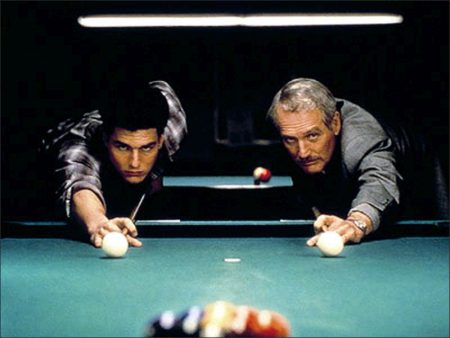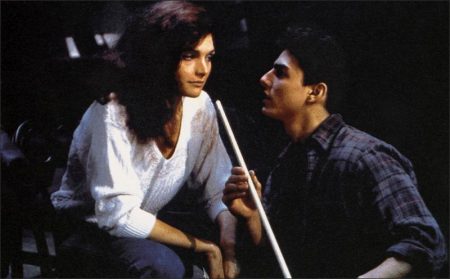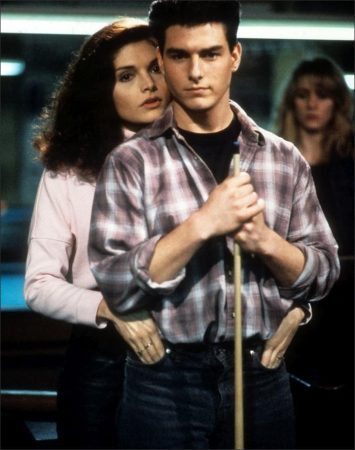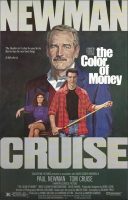Taglines: The Hustler isn’t what he used to be, but he has the next best thing. A kid who is.
The Color of Money movie storyline. Eddie “Fast Eddy” Felson, a former pool player forced into retirement by gangsters (as seen in “The Hustler”,) finds himself, self-respect, and finally, redemption when he enters a relationship with young pool player Tom Cruise very similar to his own early career.
As they travel together, Fast Eddy realizes how much he had lost, and can see the inevitable finale of their relationship as history begins to repeat itself. In an effort to avert tragedy, Eddy severs their relationship, and returns to his first love, pool. Finally, in a big Atlantic City tournament, Cruise returns the favor, and teaches Eddy the final lesson that allows him to finish his quest of re-discovery.
The Color of Money is a 1986 American drama film directed by Martin Scorsese from a screenplay by Richard Price, based on the 1984 novel of the same name by Walter Tevis. The film stars Paul Newman and Tom Cruise, with Mary Elizabeth Mastrantonio, Helen Shaver, and John Turturro in supporting roles. It features an original score by Robbie Robertson. Newman won the Academy Award for Best Actor for his performance, his first Oscar win after eight nominations, seven of them for Best Actor.
The film continues the story of pool hustler and stakehorse Edward “Fast Eddie” Felson from Tevis’ first novel, The Hustler (1959), with Newman reprising his role from the 1961 film adaptation. It begins more than 25 years after the events of the previous film, with Eddie retired from the pool circuit. Although Tevis did author a screenplay, adapting the storyline from his novel, the filmmakers decided not to use it, instead crafting an entirely different story under Tevis’ title. The Color of Money was released by Touchstone Pictures.
Film Review for Thp Color of Money
Martin Scorsese’S ”Color of Money” picks up the character of Fast Eddie Felson 25 years after he walked out of Chalkie’s pool hall into the exhausted dawn at the end of Robert Rossen’s fine 1961 melodrama, ”The Hustler.” In the person of Paul Newman, who received an Oscar nomination for his performance in the Rossen film, the former pool-hall hustler has aged with remarkable grace, his physical vitality intact and his view of the world less cynical than barroom-pragmatic.
Today Fast Eddie is a genial, silver-haired liquor salesman, immaculately dressed in the leisure wear that spells ”class” to his customers. He’s a fund of the kind of stories that sound best when told late in the afternoon, over a shot glass of Wild Turkey with beer as a chaser, to whatever bartender is the last of his calls for the day.
Fast Eddie travels light in a big white Cadillac. In fact, he’s a modern-day Flying Dutchman, a myth in polyester, doomed to move forever from one barroom to the next, never stopping very long in any one place for fear that his curse will catch up with him.
In ”The Color of Money,” Mr. Newman and Mr. Scorsese dare to do something that few serious film makers ever attempt – that is, to give us an update on a character who was complete in his own time, place and work.
The news this morning is that, against all odds, they’ve succeeded in creating a most entertaining, original film with its own, vivid, very contemporary identity and reason for being. Sharing honors with Mr. Newman, who appears certain to receive another Oscar nomination for his performance as this Fast Eddie, are Tom Cruise and Mary Elizabeth Mastrantonio, both of whom do their best work in films to date.
”The Color of Money,” which opens today at the Coronet and other theaters, is not a sequel to ”The Hustler.” Mr. Scorsese’s work is as different from the Rossen film as Michael Ballhaus’s brilliant color photography is different from Eugene Shuftan’s equally brilliant black-and-white work for Mr. Rossen.
”The Hustler” has a classic structure. It’s about moral choices that are defined in black and white. As do the people in an Odets drama of the 1930’s, Mr. Rossen’s characters mean exactly what they say in well-shaped, passionately spoken speeches.
”The Color of Money” is not so clear-cut. It’s set in another world, one full of deceptively bright, neon colors but where motives are ambiguous. Its characters communicate in wisecracks that pass for wisdom. Their mostly inarticulated feelings are expressed in close-ups of such intensity they seem to rediscover the reason close-ups were invented.
In Richard Price’s screenplay, which keeps only the title of Walter Tevis’s second Eddie Felson novel, Fast Eddie has been away from pool for 25 years, ever since the climactic game in ”The Hustler.” That was when Fast Eddie finally defeated the legendary Minnesota Fats (Jackie Gleason) and, in so doing, found himself blackballed from the game for life. In ”The Color of Money,” Fast Eddie is lured back as the manager-mentor of Vincent Lauria (Tom Cruise), a gifted but naive pool hustler well on his way to becoming the loser that the young Fast Eddie was a quarter-century ago.
Mr. Price’s screenplay doesn’t have the single-minded drive and satisfying shapeliness of the original film. It also doesn’t have any draggy ”Seventh Heaven” sentimentality in the form of Fast Eddie’s very unlikely affair with the doomed, lame (emotionally and physically) Sarah (Piper Laurie).
Instead, ”The Color of Money” is a comedy of character about Fast Eddie’s relations with the ambitious young Vincent and Vincent’s far brighter, tougher girlfriend, Carmen (Miss Mastrantonio). The film follows Fast Eddie, who has assumed a lot of the attributes of the gambler played by George C. Scott in ”The Hustler,” as he attempts to prepare the younger man for the now-respectable, annual pool competition in Atlantic City.
Fast Eddie has words of advice for every occasion. Early on, he tells the swaggering Vincent, ”You know when to say ‘Yes,’ when to say ‘No,’ and everybody goes home in a limousine.” When Vincent doesn’t seize the occasion to make a quick buck, Fast Eddie says simply: ”That’s the problem with mercy, kid. It just ain’t professional.”
What ”The Color of Money” lacks in narrative shapeliness, it makes up for in the spectacle of three fully realized, if narrowly focused, characters as they play cat-and-mouse with one another. Mr. Price and Mr. Scorsese don’t adequately prepare for the twist that ends the film, which is more emotionally soothing than believable. However, the journey to that conclusion – through a succession of pool halls, diners and motels between Chicago and Atlantic City – is most satisfying.
Mr. Newman appears to be having a ball as the aging but ever-resilient Fast Eddie. It’s a wonderfully funny, canny performance, set off by the actor’s intelligence that shines through the character without upstaging it. Mr. Cruise works successfully against his pretty-boy looks to find the comic, short-sighted nastiness that’s at the center of the younger man.
The film’s revelation is Miss Mastrantonio, whose performance as Al Pacino’s sister in ”Scarface” was hardly preparation for what she does here. Her Carmen is a neighborhood beauty on her way to the big time, with or without the Cruise character. One of the better, funnier inventions of Mr. Price’s screenplay is her recollection of the circumstances in which she met Mr. Cruise at a police station.
Among the supporting players, the standouts are Helen Shaver, who appears as the barmaid Fast Eddie seems permanently stuck on (for the moment), and John Turturro, as a pool hustler Mr. Cruise passes on his way to the top.
”The Color of Money” isn’t ”Mean Streets” or ”Raging Bull.” It is, however, a stunning vehicle – a white Cadillac among the other mainstream American movies of the season.
The Color of Money (1986)
Directed by: Martin Scorsese
Starring: Paul Newman, Tom Cruise, Mary Elizabeth Mastrantonio, Helen Shaver, John Turturro, Bill Cobbs, Alvin Anastasia, Elizabeth Bracco, Lisa Dodson, Vito D’Ambrosio, Carey Goldenberg
Screenplay by: Richard Price
Production Design by: Boris Leven
Cinematography by: Michael Ballhaus
Film Editing by: Thelma Schoonmaker
Costume Design by: Richard Bruno
Set Decoration by: Karen O’Hara
Music by: Robbie Robertson
MPAA Rating: None.
Distributed by: Buena Vista Pictures
Release Date: October 17, 1986
Views: 260











